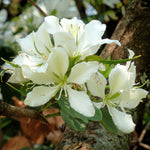Subscribe and save 10%!

Orchid Tree 'Candida' (Bauhinia variegata)
50 SEK
Unit price perExpected delivery date: 20 December to 27 December.
Applies to orders within Sweden. For other countries - see our delivery terms .
In stock - Ready to be shipped
Share
SEEDS (5pcs/bag)
Common names: Orchid Tree, Camel's Foot, Mountain Ebony, Kachnar
Scientific name: Bauhinia variegata 'Candida' / 'Alba'
Family: Fabaceae
Plant history & use:
The Orchid Tree, also known as Mountain Ebony, is a beautiful flowering tree that belongs to the pea family. It is originally from South Asia and is known for its distinctive and colorful flowers. The tree got its name from the similarity between its flowers and orchid flowers. The flowers on the Orchid Tree are very fragrant - they have a honeysuckle-like scent. These seeds are from the variety 'Candida' with white flowers.
Leaves and flower buds are edible. In India, the unopened flower buds, which are called Kachnar, are used to both prepare curries and make various pickles. You can compare it to the fact that here in Europe we use the unopened flower buds from the Caper plant to make pickles and consume.
Oil can be extracted from the seeds of the Orchid tree.
There are also some medicinal uses for the plant. It is then mainly sap from the bark that is used.
The tree thrives best in subtropical and tropical climates, but can also do well in sheltered and sunny locations in temperate climates. Read more about cultivation below.
Cultivation:
The Orchid Tree has its origins in subtropical and tropical climates in southern Asia. However, it tolerates frost and temperatures as low as -7 degrees. If you place the tree in a favorable sunny and windless place, you can theoretically succeed with outdoor cultivation all year round in the most favorable parts of Sweden - Skåne, Öland & Gotland, among others. The specified USDA zone for the tree is zone 8, which corresponds precisely to the most favorable locations in Sweden's zone 1. Read more about the relationship between Swedish plant zones & USDA zones here .
To further protect the tree during the colder months, the base of the tree can be covered with straw or the like to create protection against wind, prevent the radiation of ground heat and insulate against external penetrating cold. This can be done with basically all trees that are on the border of hardiness in an attempt to succeed in wintering outdoors.
Otherwise, you can always grow in a pot that is moved in for the winter.
Use a nutrient-rich, well-drained soil for your Orchid tree.
The orchid tree is slightly sensitive to lime - add peat or other pH-lowering substrate to your soil if it is naturally chalky (higher range of pH values - 7.5 and above) to give the tree optimal conditions for successful growth. Acceptable values for the Orchid Tree are pH 5.5-7.5.
The tree can be propagated by cuttings as well as seeds.
Sowing:
Soak the seeds for 1-2 days before sowing.
Preferably sow indoors or in a greenhouse under a 1 cm layer of soil. Keep the seed moist. The seeds can still be considered quick-germinating, it usually does not take more than about 1 week before the seeds start to germinate, some of the seeds take longer.
Characteristics:
Lifespan: Perennial
Location: Sun / Partial shade
Height: 2-10 m
Germination Time: 1-4 weeks
- Choosing a selection results in a full page refresh.
- Opens in a new window.









